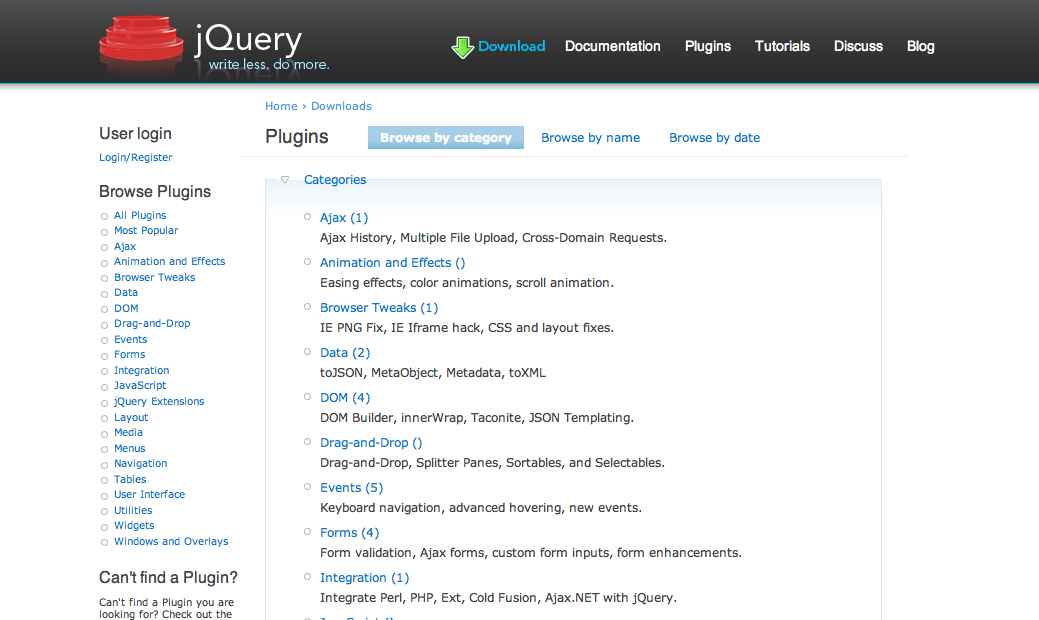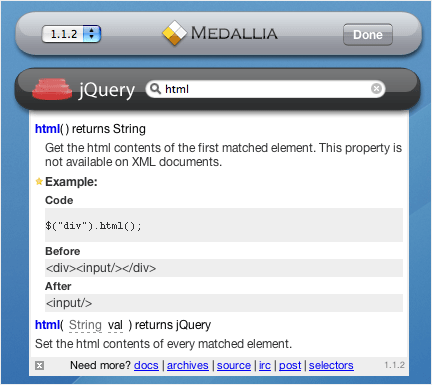I’m pleased to announce the release of jQuery 1.1.3. After many months of testing, developing, and more testing, we have a very solid release available for download. It comes with roughly 80+ fixed bugs and a handful of enhancements for good measure. Highlights include:
- Improved speeds, with DOM traversal over 800% faster than in 1.1.2.
- A re-written event system, with more graceful handling of keyboard events.
- A re-written effects system (with an accompanying fx test suite), featuring faster execution and better cross-platform support.
Update – July 4th: We just finished a quick bug fix release, versioned 1.1.3.1, which fixes a couple of outstanding issues.
Download:
As always, if you find any bugs with this release, please post them to the jQuery Bug Tracker.
1.1.3 Features
Massive Selector Speed Improvements
Due to popular demand, we dug deep and made some major changes to jQuery’s selector engine. Here’s a breakdown of the speed improvements that were made to jQuery itself. All numbers are based on the SlickSpeed test suite.
| Browser |
jQuery 1.1.2 |
jQuery 1.1.3 |
% Improvement |
| IE 6 |
4890ms |
661ms |
740% |
| Firefox 2 |
5629ms |
567ms |
993% |
| Safari 2 |
3575ms |
475ms |
753% |
| Opera 9.1 |
3196ms |
326ms |
980% |
| Average improvement: |
867% |
Additionally, we tested the improved code base against some of the other popular selector libraries, again with the SlickSpeed test suite.
| Browser |
Prototype |
jQuery |
Mootools |
Ext |
Dojo |
| IE 6 |
1476ms |
661ms |
1238ms |
672ms |
738ms |
| Firefox 2 |
219ms |
567ms |
220ms |
951ms |
440ms |
| Safari 2 |
1568ms |
475ms |
909ms |
417ms |
527ms |
| Opera 9.1 |
220ms |
326ms |
217ms |
296ms |
220ms |
A couple things to notice when looking at the speed suite results are that:
- We’re over 800% faster than we were in jQuery 1.1.2.
- We’re the fastest framework in the most popular browser, Internet Explorer 6.
- We’re the only framework that doesn’t give incorrect results.
- And all of this comes at no expense to you — jQuery is still the same 20KB that you’ve come to expect and enjoy.
New Selectors
Unicode Selectors: This is a huge addition for those of you who want to use Unicode attribute values, IDs, class names, or tag names. You can now use them directly in jQuery selectors:
$("div.å°åŒ—")
$("div#å°åŒ—")
$("foo_barå°åŒ—")
$("div[@id=å°åŒ—]")
Escape Selectors: A frequently requested feature you can now select elements by ID (or other selector) that uses a special character, for example this will find the div that has the ID of “foo.bar”:
$("div#foo\\\\.bar")
Inequality Selector: While this selector isn’t part of the CSS specification, it’s frequently used and included in other selector libraries, so we decided to add it in:
$("div[@id!=test]")
:nth-child() improvements: This selector allows you to locate specific child elements. We’ve supported selectors like :nth-child(1) and :nth-child(odd) since the beginning of jQuery, now we’ve added advanced :nth-child selectors, such as:
$("div:nth-child(2n)")
$("div:nth-child(2n+1)")
$("div:nth-child(n)")
Space-separated attributes: After being removed in jQuery 1.0, this selector has now been brought back by popular demand. It allows you to locate individual items in a space-separated attribute (such as a class or rel attribute).
$("a[@rel~=test]")
Animation Improvements
Speed: Animations are now significantly faster and smoother. Additionally, you can run more simultaneous animations without incurring any speed hits.
Testing: We now have a dedicated test suite for animations — which has allowed us to fix a number of pressing animation bugs that weren’t previously locatable.
DOM Event Listeners
Internally, the jQuery Event system has been overhauled to use the DOM Event system, rather than the classical “onclick” style of binding event handlers. This improvement allows you to be more unobtrusive in your use of the library (not affecting the flow of other libraries around it). Additionally, it helped to resolve some of the outstanding issues that existed with binding event listeners to IFrames.
Event Normalization
Some great steps have been taken to normalize keyboard and mouse events. You can now access the event.which property to get most details about the specific key or button that was pressed.
Multiple .is()
The .is() method can now take multiple selectors, separated by a comma. This allows you to test your jQuery set against multiple selectors.
$("div").is(":visible, :first")
Browser Version
A commonly requested feature, by plugin authors, was a way to determine what browser version their users were using. We now expose an extra property through which this information can be accessed.
jQuery.browser.version
More Bug Fixes
Please see the ticket listing for the full list of all issues resolved in this release.
The Future of jQuery
We’ve been very concerned with the direction and progress being made towards furthering the jQuery project. We’re focusing on a number of different aspects now, but the primary concern is still the advancement of the core jQuery library. We’ve spec’d out the next two releases, which you can read more about below:
jQuery 1.1.4
This will be the last release of the jQuery 1.1 branch – another bug fix release with some minor improvements. This release will also mark a number of methods as deprecated, in accordance with the upcoming jQuery 1.2 release.
We’re currently planning on having this release take place at the end of July.
This will be the next major release of jQuery, containing a significant number of new features. The full details of this release can be found in the jQuery 1.2 Roadmap.
Your comments and feedback on this release are greatly appreciated. It’s still in planning, so nothing is completely final. We’re currently planning on releasing jQuery 1.2 by the end of August.
jQuery Books
We’re now up to 4 jQuery books being written and, just as importantly, they’re all being written by members of the jQuery team (so you’ll know that you’re getting good information).
The books and their authors are as follows:
- Learning jQuery by Karl Swedberg and Jonathan Chaffer – due out early July 2007 (Packt Publishing).
- jQuery Reference Guide by Karl Swedberg and Jonathan Chaffer – due out Summer 2007 (Packt Publishing).
- jQuery Quickly by Yehuda Katz and Bear Bibeault (Manning Publishing).
- Designing with jQuery by Glen Lipka (Manning Publishing).
This is really fantastic news. I’ve been able to read some of the pre-release chapters and I think you’re going to be in for a real treat with these books.
jQuery Talks and Conference
I’d like to announce some talks being given about jQuery in the upcoming months. Specifically, there will be a number of talks given about jQuery at both of the Ajax Experience conferences.
At the San Francisco Ajax Experience, John Resig will be giving an introductory overview to jQuery followed by an advanced jQuery talk. Glen Lipka will be giving a talk on designing with jQuery.
At the Boston Ajax Experience, John and Glen will be presenting again, and will be joined by Paul Bakaus to give a talk on developing intense applications and games with jQuery.
Since there’s going to be quite a few members of the jQuery team at the Boston Ajax Experience, we’d like to announce that we’re planning on doing a small, one day, jQuery Conference the next day after the Ajax Experience. This will be the perfect opportunity for you to meet the jQuery team and ask any nagging questions that you have. We’ll also be giving a number of talks about specific aspects of jQuery. We’ll have more details about this soon.
jQuery UI
Today, we’re also pleased to announce a secret project that we’ve been working on: jQuery UI. This project, being written by Paul Bakaus, is a whole new Drag & Drop library being developed from the ground up with speed and extensibility taken into consideration. Additionally, great care is being taken to have the code be fully documented and tested — allowing many other developers to use and help extend it.
This library will contain full code for Draggables, Droppables, Sortables, Resizables, and a Slider.
You can take a look at some of Paul’s early work in the SVN repository.
Funding and Thank You
The new jQuery UI library marks a new step for the jQuery project: This is a piece of code whose development we’re sponsoring using money donated by you, the jQuery users!
This is being made possible in two ways: first by your continued support and donations to the jQuery project, and second by a generous server donation by Media Temple. This is allowing us to focus our financial resources on other projects that’ll benefit everyone the most.
So I’d like to take this opportunity to request additional donations to help us continue funding exciting new work that you’ll be able to use in your web sites. Any help will be greatly appreciated.
Once again, I’d like to thank the jQuery team and everyone who has helped to make this release possible. It’s been a lot of work, but I hope you’ll be as pleased with this release as we are. Thank you — and thanks for using jQuery!


